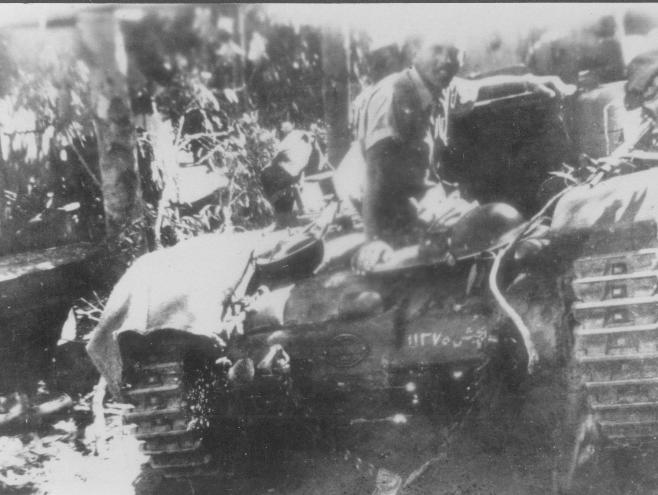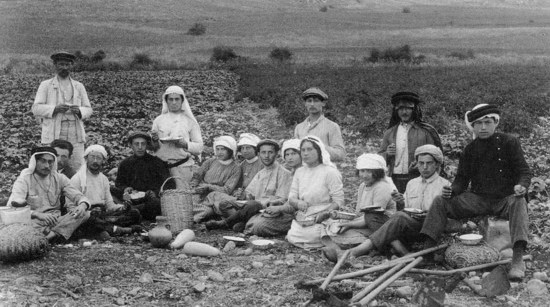|
Kvutza
A kvutza, kvutzah, kevutza or kevutzah ( "group") is a form of cooperative settlement that was founded in the Second Aliyah and developed in the Third Aliyah, its principles are based on the existence of a cooperative, communal, small and intimate group. The settlers of the group lived in full cooperation (a common fund for expenses and income, without private property) and without external control (warehouses etc). Ideology The "Kvutzas" were influenced by the socialist and communist principles and thoughts. This influence caused a surge of settlements, built on community ownership and agriculture. later, most of the Kvutza's turned into Kibbutz's. History First there were ''kvutzot'' (plural of kvutza) in the sense of groups of young people with similar ideals living and working together; and after 1909 and for many years to follow, in the sense of collective settlements created by such groups. The kvutza collective settlement was distinguished from the ''kibbutz'' settle ... [...More Info...] [...Related Items...] OR: [Wikipedia] [Google] [Baidu] |
Kibbutz
A kibbutz ( / , ; : kibbutzim / ) is an intentional community in Israel that was traditionally based on agriculture. The first kibbutz, established in 1910, was Degania Alef, Degania. Today, farming has been partly supplanted by other economic branches, including Factory, industrial plants and high-tech Business, enterprises. Kibbutzim began as utopian communities, a combination of socialism and Zionism. In recent decades, some kibbutzim have been Privatization, privatized and changes have been made in the communal lifestyle. A member of a kibbutz is called a ''kibbutznik'' ( / ; plural ''kibbutznikim'' or ''kibbutzniks''), the suffix ''-nik'' being of Slavic languages, Slavic origin. In 2010, there were 270 kibbutzim in Israel with a total population of 126,000. Their factories and farms account for 9% of Israel's industrial output, worth US$8 billion, and 40% of its agricultural output, worth over US$1.7 billion. Some kibbutzim had also developed substantial high-tech and mi ... [...More Info...] [...Related Items...] OR: [Wikipedia] [Google] [Baidu] |
Degania Alef
Degania Alef (, ) is a kibbutz in northern Israel. The Jewish communal settlement ('' kvutza'') was founded in 1910, making it the earliest Labor Zionist farming commune in the Land of Israel. Its status as "the mother of all kibbutzim" is sometimes contested based on a later distinction made between the smaller ''kvutza'', applying to Degania in its beginnings, and the larger ''kibbutz''. It falls under the jurisdiction of the Emek HaYarden (Jordan Valley) Regional Council. Degania Alef and its neighbor Degania Bet both lie south of the southern shore of the Sea of Galilee and along the Jordan River. As of it had a population of . Etymology ''Degania'' means " cornflower" and is derived from דגן ''dagán'', meaning "grain". After the first phase at Umm Junieh, the group and its settlement was simply called ''Degania'', ''Alef'' being added only after the establishment of the associated kibbutzim of ''Degania Bet'' and ''Gimel'' in 1920. Alef, bet and gimel are the ... [...More Info...] [...Related Items...] OR: [Wikipedia] [Google] [Baidu] |
Kibbutz
A kibbutz ( / , ; : kibbutzim / ) is an intentional community in Israel that was traditionally based on agriculture. The first kibbutz, established in 1910, was Degania Alef, Degania. Today, farming has been partly supplanted by other economic branches, including Factory, industrial plants and high-tech Business, enterprises. Kibbutzim began as utopian communities, a combination of socialism and Zionism. In recent decades, some kibbutzim have been Privatization, privatized and changes have been made in the communal lifestyle. A member of a kibbutz is called a ''kibbutznik'' ( / ; plural ''kibbutznikim'' or ''kibbutzniks''), the suffix ''-nik'' being of Slavic languages, Slavic origin. In 2010, there were 270 kibbutzim in Israel with a total population of 126,000. Their factories and farms account for 9% of Israel's industrial output, worth US$8 billion, and 40% of its agricultural output, worth over US$1.7 billion. Some kibbutzim had also developed substantial high-tech and mi ... [...More Info...] [...Related Items...] OR: [Wikipedia] [Google] [Baidu] |
Collective Settlement
An intentional community is a voluntary residential community designed to foster a high degree of social cohesion and teamwork. Such communities typically promote shared values or beliefs, or pursue a common vision, which may be political, religious, utopian or spiritual, or are simply focused on the practical benefits of cooperation and mutual support. While some groups emphasise shared ideologies, others are centred on enhancing social connections, sharing resources, and creating meaningful relationships. Although intentional communities are sometimes described as alternative lifestyles or social experiments, some see them as a natural response to the isolation and fragmentation of modern housing, offering a return to the social bonds and collaborative spirit found in traditional village life. The multitude of intentional communities includes collective households, cohousing communities, coliving, ecovillages, monasteries, survivalist retreats, kibbutzim, Hutte ... [...More Info...] [...Related Items...] OR: [Wikipedia] [Google] [Baidu] |
Rural Community Development
Rural community development encompasses a range of approaches and activities that aim to improve the welfare and livelihoods of people living in rural areas. As a branch of community development, these approaches pay attention to social issues particularly community organizing. This is in contrast to other forms of rural development that focus on public works (e.g. rural roads and electrification) and technology (e.g. tools and techniques for improving agricultural production). Rural community development is important in developing countries where a large part of the population is engaged in farming. Consequently, a range of community development methods have been created and used by organisations involved in international development. Most of these efforts to promote rural community development are led by 'experts' from outside the community such as government officials, staff of non-governmental organizations and foreign advisers. This has led to a long debate about the i ... [...More Info...] [...Related Items...] OR: [Wikipedia] [Google] [Baidu] |
Hebrew Words And Phrases
Hebrew (; ''ʿÎbrit'') is a Northwest Semitic languages, Northwest Semitic language within the Afroasiatic languages, Afroasiatic language family. A regional dialect of the Canaanite languages, it was natively spoken by the Israelites and remained in regular use as a first language until after 200 CE and as the Sacred language, liturgical language of Judaism (since the Second Temple period) and Samaritanism. The language was Revival of the Hebrew language, revived as a spoken language in the 19th century, and is the only successful large-scale example of Language revitalization, linguistic revival. It is the only Canaanite language, as well as one of only two Northwest Semitic languages, with the other being Aramaic, still spoken today. The earliest examples of written Paleo-Hebrew alphabet, Paleo-Hebrew date back to the 10th century BCE. Nearly all of the Hebrew Bible is written in Biblical Hebrew, with much of its present form in the dialect that scholars believe flourish ... [...More Info...] [...Related Items...] OR: [Wikipedia] [Google] [Baidu] |
Cooperatives In Israel
A cooperative (also known as co-operative, coöperative, co-op, or coop) is "an autonomous association of persons united voluntarily to meet their common economic, social and cultural needs and aspirations through a jointly owned and democratically-controlled enterprise". Cooperatives are democratically controlled by their members, with each member having one vote in electing the board of directors. They differ from collectives in that they are generally built from the bottom-up, rather than the top-down. Cooperatives may include: * Worker cooperatives: businesses owned and managed by the people who work there * Consumer cooperatives: businesses owned and managed by the people who consume goods and/or services provided by the cooperative * Producer cooperatives: businesses where producers pool their output for their common benefit ** e.g. Agricultural cooperatives * Purchasing cooperatives where members pool their purchasing power * Multi-stakeholder or hybrid cooperatives tha ... [...More Info...] [...Related Items...] OR: [Wikipedia] [Google] [Baidu] |
Agriculture In Israel
Agriculture in Israel is a highly developed industry. Israel is an exporter of fresh produce and a leader in Agricultural research In Israel, agricultural technologies. The southern one-half of Israel is desert and irrigation is required for growing crops. The northern one-half is more conducive to rain-fed agriculture. According to the World Bank, 29.7 percent of Israel is agricultural land. The shortage of water is a constraint. In 2008, agriculture represented 2.5% of total GDP and 3.6% of exports. Israel is not self-sufficient in growing food. In 2021, Israel's agricultural imports totaled 8,791 million and agricultural exports totaled 2,445 million dollars. Grains, oilseeds, meat, coffee, cocoa, and sugar were among the imports. Israel is home to two unique types of agricultural communities, the kibbutz and moshav, which developed as Jews immigrated to the land that became the country of Israel and embarked on rural settlement. As of 2016, kibbutzim provided Israel with abou ... [...More Info...] [...Related Items...] OR: [Wikipedia] [Google] [Baidu] |
Agricultural Labor
Agriculture encompasses crop and livestock production, aquaculture, and forestry for food and non-food products. Agriculture was a key factor in the rise of sedentary human civilization, whereby farming of domesticated species created food surpluses that enabled people to live in the cities. While humans started gathering grains at least 105,000 years ago, nascent farmers only began planting them around 11,500 years ago. Sheep, goats, pigs, and cattle were domesticated around 10,000 years ago. Plants were independently cultivated in at least 11 regions of the world. In the 20th century, industrial agriculture based on large-scale monocultures came to dominate agricultural output. , small farms produce about one-third of the world's food, but large farms are prevalent. The largest 1% of farms in the world are greater than and operate more than 70% of the world's farmland. Nearly 40% of agricultural land is found on farms larger than . However, five of every six farms in t ... [...More Info...] [...Related Items...] OR: [Wikipedia] [Google] [Baidu] |
Intentional Communities In Israel
An intention is a mental state in which a person commits themselves to a course of action. Having the plan to visit the zoo tomorrow is an example of an intention. The action plan is the ''content'' of the intention while the commitment is the ''attitude'' towards this content. Other mental states can have action plans as their content, as when one admires a plan, but differ from intentions since they do not involve a practical commitment to realizing this plan. Successful intentions bring about the intended course of action while unsuccessful intentions fail to do so. Intentions, like many other mental states, have intentionality: they represent possible states of affairs. Theories of intention try to capture the characteristic features of intentions. The ''belief-desire theory'' is the traditionally dominant approach. According to a simple version of it, having an intention is nothing but having a desire to perform a certain action and a belief that one will perform this action. ... [...More Info...] [...Related Items...] OR: [Wikipedia] [Google] [Baidu] |
Culture Of Israel
The culture of Israel is closely associated with Jewish culture and rooted in the Jewish history of the diaspora and Zionist movement. It has also been influenced by Arab culture and the history and traditions of the Arab Israeli population and other ethnic minorities that live in Israel, among them Druze, Circassians, Armenians and others. Tel Aviv and Jerusalem are considered the main cultural hubs of Israel. The ''New York Times'' has described Tel Aviv as the "capital of Mediterranean cool," ''Lonely Planet'' ranked it as a top ten city for nightlife, and ''National Geographic'' named it one of the top ten List of beaches in Israel, beach cities. Similarly, Jerusalem has earned international acclaim; Time (magazine), ''Time'' magazine included it in its list of the "World’s Greatest Places," and Travel + Leisure, ''Travel+Leisure'' ranked it as the third favorite city in ME and Africa among its readers. Israel's List of Israeli museums, museums, numbering over 200, draw T ... [...More Info...] [...Related Items...] OR: [Wikipedia] [Google] [Baidu] |
Cooperative Settlement
A cooperative (also known as co-operative, coöperative, co-op, or coop) is "an autonomous association of persons united voluntarily to meet their common economic, social and cultural needs and aspirations through a jointly owned and democratically-controlled enterprise". Cooperatives are democratically controlled by their members, with each member having one vote in electing the board of directors. They differ from collectives in that they are generally built from the bottom-up, rather than the top-down. Cooperatives may include: * Worker cooperatives: businesses owned and managed by the people who work there * Consumer cooperatives: businesses owned and managed by the people who consume goods and/or services provided by the cooperative * Producer cooperatives: businesses where producers pool their output for their common benefit ** e.g. Agricultural cooperatives * Purchasing cooperatives where members pool their purchasing power * Multi-stakeholder or hybrid cooperatives tha ... [...More Info...] [...Related Items...] OR: [Wikipedia] [Google] [Baidu] |






